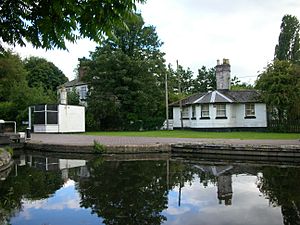Autherley Junction facts for kids
Quick facts for kids Autherley Junction |
|
|---|---|

Autherley Junction. A narrowboat is going down the stop lock.
|
|
| Specifications | |
| Status | Open |
| Navigation authority | Canal & River Trust |
| History | |
| Date completed | 1835 |
Autherley Junction is a special place where two canals meet. It's like a crossroads for boats! Here, the Shropshire Union Canal ends and joins the Staffordshire and Worcestershire Canal. You can find it near Oxley, just north of Wolverhampton in the West Midlands, England.
Contents
History of Autherley Junction
Early Canals and Connections
The Staffordshire and Worcestershire Canal opened way back in 1772. It was a really important waterway. It connected the Trent and Mersey Canal in the north to the River Severn in the south. This allowed goods to travel easily between the Potteries (where pottery was made) and the south west of England.
Later, another important connection was made. About half a mile south of Autherley Junction, the Birmingham Canal Navigations joined the Staffordshire and Worcestershire Canal. This new route helped manufactured goods move north.
The New Canal Arrives
In 1835, a new canal called the Birmingham and Liverpool Junction Canal opened. This canal was different. It was built to be more direct, using big cuttings and embankments. It also had groups of locks, called "flights," to help boats go up or down hills. This new canal connected the Chester Canal at Nantwich to the Staffordshire and Worcestershire Canal at Autherley.
This new, faster canal changed things a lot. Most of the boats that used to travel north from Birmingham started using this newer route. This meant the Staffordshire and Worcestershire Canal lost a lot of business.
The Tolls Dispute
Because the new canal took so much traffic, the Staffordshire and Worcestershire Canal could only charge tolls for a very short section of their canal. To try and make up for lost money, they charged very high tolls for this small section. This made it very expensive for boats to pass through.
To fix this problem, the Birmingham and Liverpool Junction Canal worked with the Birmingham Canal company. They planned a new canal called the Tettenhall and Autherley Canal. This new canal would have crossed over the Staffordshire and Worcestershire Canal using an iron bridge. It would have then dropped down through three locks to join the canal just above the stop lock.
They even presented a bill (a proposed law) to Parliament to build it. But the new canal was never built. Why? Because the Staffordshire and Worcestershire company decided to lower their tolls instead. They realized it was better to charge less and keep some business than to lose it all!
Later, in 1846, the Birmingham and Liverpool Junction Canal became part of the larger Shropshire Union Canal network.
Location and Features
Autherley Junction is located on a high point of the Staffordshire and Worcestershire Canal. This high point is called the "summit level." It's about 340 feet (104 meters) above sea level. It's also the highest point on the main line of the Shropshire Union Canal. From here, the Shropshire Union Canal goes downhill through 46 locks all the way to Ellesmere Port.
The Stop Lock
Just before the junction, there's a special lock called a stop lock. This stop lock was built by the Birmingham and Liverpool Junction Canal. It only has a very small drop, just a few inches. Its main purpose was to make sure that the new canal didn't take too much water from the Staffordshire and Worcestershire Canal.
Even today, this stop lock is still used. Both canals are now looked after by the Canal & River Trust. So, taking water from one canal to another is no longer a problem like it used to be!


